Articles
K-12 Testing and Assessment Standards
THE IMPORTANCE OF PLAY IN PREPARING FOR STANDARDIZED TESTING
By Matt Levinson Edutopia News 3/14/2014
Standardized tests can be a wonderful teaching tool to enrich and deepen classroom learning.
What?! The prevailing wisdom states that standardized testing drains the life out of a classroom and saps students of interest and engagement, brings on unnecessary and at times crippling stress, and limits the view of what students are really learning in school. 
Teaching to the test is a problem, for sure. But using the format of a standardized test as a teaching tool can be a boon to student learning. The question is how to do this successfully and in a way that captivates student interest.
Here are a few ways to use the format of standardized tests as a strategy to promote student engagement:
Play with Question Stems
Have students create the answer responses to a question stem, thinking carefully about “wrong” answers and finding the right language to construct the “correct” response. This is a highly analytical exercise and challenges students to really know and understand the concept being addressed in the question.
Flip the Question
Have students construct the question based on the answer responses. This forces students to identify the patterns and themes evident in the answer responses and thus arrive at the big idea in the question.
A “No-Stakes” Review
At the end of a class in a particular subject area, have students answer one multiple-choice, standardized test type of question to see if they grasped an idea covered in class. This is a good dipstick exercise to garner immediate feedback. Time columnist Annie Murphy Paul shares the example of Columbia Middle School in St. Louis, Missouri, where teachers have students take a quick, “no-stakes” quiz at the end of each class to see what they learned.
The Quiz Show Format
Play “Who Wants to be a Millionaire?” with multiple-choice questions. The popular ’90s TV show invited participants to answer a series of questions, sometimes enlisting the help of peers through the “Call a Friend” option, in which the participant could call a friendly source of information. The show also employed the “50/50” option, where two incorrect responses were eliminated from the answer list so that the participant could choose between the last two options. Teachers can break the class into teams to play this game. In a more modern version, the “Call a Friend” option could give students one minute to Google the answer, forcing them to use intelligent search language to find the “right” answer. Students could also text a friend to get extra help.
The Build Your Own Test
Give the class a mixed up practice test, with the questions scrambled and in no apparent order of difficulty. Have teams of students re-order the questions, moving from easiest to hardest, being prepared to explain and defend why a certain question was easy or difficult. This also invites the important conversation to consider that, when taking a standardized test, all questions are actually equal, with no single question having more value. Many students get hung up on the “hard” question and spend too much time on that one instead of moving through the test to answer the most questions correctly.
Dispute the Question
Have students debate the merits of the wording of a particular question to find flaws, bias or shortcomings and then rewrite the question with more careful wording.
Building experiences for students to “play” with a test can help to defuse anxiety, create familiarity and comfort, offer concrete strategies for success, promote collaboration and problem solving, and open up important conversations around taking standardized tests.
STUDENTS TO TAKE PRACTICE VERSION OF NEW SMARTER BALANCED ASSESSMENT IN APRIL
By Brandon Daubs
Healdsburg Tribune 3/26/2014
There’s less of a need to sharpen every no. 2 pencil in the box this year, as April 7 marks the start of the new Smarter Balanced Assessment to be held in schools across the state. The new test is a part of Common Core State Standards, and will replace the STAR testing of previous years.
The Smarter Balanced Assessment is designed to better analyze student comprehension of test materials by a number of means, including questions that scale to the level of student understanding, sometimes granting partial credit for mostly-correct answers. It also requires students to show all of their work in order to demonstrate a deeper knowledge of the subject and show complex problem solving skills.
“It’s common core aligned,” said Healdsburg Unified School District Director of Curriculum and Instruction Annie Millar, of the new test. “The whole thing about providing evidence for how you arrived at the answer is totally common core…the depth of the questions is more profound than with the STAR. It’s moving away from multiple choice to questions that require higher thinking, that are more complex, that may have multiple steps for students to work through.”
Rather than pencils and Scantron, the Smarter Balanced Assessment will require the use of computers, tablets and laptops to deliver a test through the state-run website. As a result, this first year of testing will help districts determine whether they have enough computers and bandwidth support for that many students accessing the Internet at once.
“We have to make sure our technology is in place and working,” said Cloverdale Unified School District Superintendent Steve Jorgensen.
“We have to make sure every student has their identification code to access the test…there’s the logistics of getting the correct test loaded, besides the general functions of operating what the test is asking to do.” Jorgensen cites examples such as the need to “click and drag” components of a test question, in some cases, and also to underline some sentences.
In preparation for the coming test, Windsor Unified School District (WUSD) Director of Educational Services Lisa Saxon said WUSD purchased 400 iPads, keyboards and headphones for use during the test.
Rather than evaluate the performance of students this year, the main goal of the Smarter Balanced Assessment will be to provide the state with feedback on their question quality and to test servers that must be able to handle millions of students signing on to take the test without crashing or slowdown. Also, the test will help more local school districts identify any problems with their own testing process.
“We’re testing the test,” said Saxon. “The data that the CDE (California Department of Education) is after is test question quality, before their operational test is rolled out in 2015. They’re looking for accuracy and fairness of test questions—this is mostly all for them, in making sure their test is the best that it can be.”
Student test results will not be shared with the district, as this is the first year of the Smarter Balanced Assessment, and will serve primarily as a practice run.
NEW COMMON CORE EXAMS WILL TEST WHETHER A ROBO-GRADER IS AS ACCURATE AS A HUMAN
By Jill Barshay
Hechinger Report – 3/25/2014
Millions of elementary, middle and high school students in 14 states and Washington, D.C. may have their essays graded by computers next year if initial tests of robo-grading prove to be accurate.
A multi-state consortium known as PARCC that is developing the tests said it hoped to use essay-grading software as soon as Spring 2015, when its new computerized tests are scheduled to roll out. The new tests are primarily aimed at assessing whether students are learning new Common Core education standards, but test administrators are also experimenting with new testing technologies.
“One benefit of computerized scoring is you can get scores back sooner and it drives down costs,” explained Laura McGiffert Slover, chief executive officer of PARCC Inc., a non-profit that stands for Partnership for Assessment of Readiness for College and Careers. It is coordinating the development of new assessments for 14 states* plus the District of Columbia.
McGiffert Slover talked about computerized grading in a telephone briefing with reporters on March 20. Beginning Monday, PARCC will administer trial versions of the new tests to 1 million students, who will be asked to answer not only multiple choice questions but also write open response answers and essays. These sentences and essays will graded by humans. But the human grades will be used to “teach” the computers how to mark essays.
Jeff Nellhaus, director of policy, research and design at PARCC, explained that you need to have papers that have been scored by humans to calibrate the machines. Afterwards, the calibrated machines will grade additional essays to make sure the computer marks approximate human marks. If the computers pass that test, Nellhaus said that PARCC “could use the robo-graders as a second score with the roll out.” That is, instead of using two human graders for each essay, there would be one human and one computer.
Essay-grading software has been used in testing since at least 2004, when Indiana was the first state to use computer-scored essays in its statewide assessments. But critics have pointed to many problems in the way that computers have graded essays, and the technology is far from perfect. For example, The New York Times reported in 2012 that MIT professor Les Perelman tested an ETS (Education Testing Service) computer grader and found that it gave lower marks to a well-argued essay than a longer essay with nonsensical sentences. Pearson, which will be administering the PARCC tests, refused to allow Prof. Perelman to test its software-grading system.
*The 14 states are Arizona, Arkansas, Colorado, Illinois, Louisiana, Maryland, Massachusetts, Mississippi, New Jersey, New Mexico, New York, Ohio, Rhode Island and Tennessee.
COUNTY SCHOOLS PREPARE FOR ROLLOUT OF NEW STATE TESTS
By Kerry Benefield
The Press Democrat – 3/17/2014
Ready, set … test.
School children across California will fire up computers rather than sharpen pencils for the new standardized test being administered for the first time this year. The testing window opens Tuesday, although nearly all Sonoma County schools are expected to commence exams after April 7. “Ready or not, here it comes,” said Mike Cole, director of technology for Petaluma City Schools, Sonoma County’s second largest school district.
For the first year only, results will not be given to districts, students or parents about students’ performance. This year is being billed simply as a test of the test — a full dress rehearsal before 2015 when individual and school-wide scores will be published. That has taken some of the pressure off students and educators, but apprehension remains as an entirely new test and delivery system are rolled out. “We have to blow this out and see where we need to make corrections,” said Steve Herrington, superintendent of the Sonoma County Office of Education. 
The computerized test, called “Smarter Balanced,” marks a dramatically different format for students, teachers and administrators. The fill-in-the-bubble format of the Standardized Testing and Reporting (STAR) program of old are history. And the format has put pressure on districts’ technology, some of which has been ignored as budget cuts limited spending in recent years. “There are infrastructure needs that haven’t been addressed for years that are coming to light,” said Rick Edson, Santa Rosa City Schools’ information technology director who has been in the post less than two months.
Wireless access is an issue, as is the number of computers to serve Sonoma County’s largest school district, he said. “We are doing everything we possibly can right now,” he said. “The trickiest part is probably utilizing what we do have and creating and scheduling test time.” “It’s all hands on deck,” he said.
Across the county teachers are being trained on new technology, students are being introduced to both the practice tests and the electronic devices they will have to use come test day. “It not only gives a trial run for the teachers and students, but the system,” Petaluma’s Cole said of this year’s round of testing. “It’s a big deal.”
To that end, the vast majority of Sonoma County’s school district have upgraded their bandwidth, invested in new laptop computers, and undergone training on both curriculum and the technology know-how needed to administer the test. “I think what we are doing is trying to eliminate as many bumps as we can,” said Dan Bienkowski, director of information technology for the Sonoma County Office of Education. “This is not something we have done before. You have six million kids (statewide) that are going to be testing in that period.”
Bienkowski has spent months helping districts increase their bandwidth so when students log on to take the test they aren’t faced with the dreaded spinning wheel that signals delayed access. The investment in technology has come rapidly after years of neglect. “We have not really invested in that in the last five, six years in California,” said Rick Phelan, program director of Technology for Learning in the Sonoma County Office of Education which has spearheaded teacher training sessions. “A lot of schools are reinvesting in their technology infrastructure and finding they are not up to date,” he said.
But Phelan, who has led a large number of training and workshop sessions for teachers, said districts should not buy equipment simply for a two-week test. The newly-adopted Common Core curriculum incorporates technology more than any program used previously. Petaluma’s Cole said the district has been aggressive in upgrading its infrastructure. “Much of the Common Core teaching and much of the way teaching is being delivered is using the Internet and so we are seizing that to maximize,” he said.
But teachers and administrators still expect some nerves and glitches to mark this inaugural testing season. And not just from the students. “We just don’t know what to expect. Once we do it once, we’ll feel better about it, I hope,” said Bob Cmelak, Superintendent of the Waugh School District in Petaluma. “We figure if we are feeling pressure, I believe everyone is feeling pressure.”
“I’m scared to death that I’m going to have a technical problem,” said Two Rock fifth grade teacher Pat Godoski. “You think, ‘Is this going to work?” For that reason, the no-results policy in the inaugural year makes sense, she said. “I would like them to work the bugs out. I don’t want to be accountable for their bugs,” she said.
Staff Writer Kerry Benefield writes an education blog at extracredit.blogs.pressdemocrat.com. She can be reached at 526-8671, kerry.benefield@press democrat.com or on Twitter @benefield.
JOIN THE DISCUSSION
Common Core; teaching kids what to think. Instead of how to think. The corporate/globalist interests behind this curriculum care about profits and creating obedient serfs. Parents and teachers across the Country are realizing all the damage that Common Core will cause. Parents should look into it, there is plenty of information out there now. Orlean Koehle is a local woman; a lifelong educator wrote a book; Common Core A Trojan Horse for Education Reform. After learning about this curriculum, homeschooling and private/charter schooling will have your attention.
James Bennett’s response to this article shows a typical 19th century conservative’s mentality toward progressive education. We now have over 7,000 students dropping out of school every day in this country not to mention how far U.S. students have fallen behind other industrialize world countries in student assessment. What the Common Core is designed to do is raise the standards of K-12 education uniformly across the country. A recent Hechinger Report article cited a Scholastic survey of over 20,000 teachers; 57 percent said that the Common Core will have a positive effect on their students; a third said that it would have no effect; and 8 percent felt that it would have a negative impact. Seventy-five percent of the teacher surveyed said they were prepared for the new standards.
Some parents don’t like the standards because it will force their children to take more responsibility for their own education and to do more collaboration with their classmates. Teachers will take more of a mentor role rather than just lecture.
Is the Common Core perfect? No. Will it have to be improved upon as it’s implemented? Yes. The Common Core has come into existence because the No Child Left Behind structure failed miserably and the Common Core might fail too (although I doubt it) but the point is that we have to keep trying to find ways to educate our children. Their future is at stake and so is the future of America.
THE WRONG VILLAIN: CRITICS SHOULD FOCUS ON RACE TO THE TOP NOT ON COMMON CORE
By Paige Jaeger
School Library Journal 01/20/2014
The Common Core State Standards (CCSS) are under attack from many arenas, but critics are not focusing on the real target. They should instead be honing in on Race to the Top (RttT), a 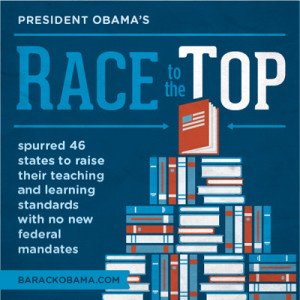 $4.35 billion competitive grant sponsored by the U.S. Department of Education to reform schools, with a focus on measuring student success and holding teachers and principals accountable as a strategy to close the achievement gap, and reforming curriculum. RttT pointed to the Common Core as the “exemplar” standards, but the Common Core is not the villain.
$4.35 billion competitive grant sponsored by the U.S. Department of Education to reform schools, with a focus on measuring student success and holding teachers and principals accountable as a strategy to close the achievement gap, and reforming curriculum. RttT pointed to the Common Core as the “exemplar” standards, but the Common Core is not the villain.
The RttT has driven the ills of excessive testing; teacher measurement; data-archiving monsters that will track “achievement” by numbers using many days annually in formal assessment; and requiring monetary expenditures, which often are being administered Robin Hood style, on electronic devices or computers. This is what should be questioned.
All over the world, teachers are learning to repackage their curriculum so that students uncover and discover, rather than merely cover material. If the U.S. education system does not adapt, our students are likely to be standing behind a student from India or Turkey who has, according to Intel, learned “to lead and participate in the global economy” (http://ow.ly/rOB8m). While our students build travel brochures and call that endeavor research, international students assess the mortality rates in various countries and propose action plans for remediation. A Harvard review of the international educational assessment data warns, “The United States’ failure to educate its students leaves them unprepared to compete and threatens the country’s ability to thrive in a global economy” (http://ow.ly/rDBTd).
Our founding fathers believed that education should be for all, even for the impoverished–whom other countries may not be educating or testing. Until recently, we have done that better than most other nations. In an effort to remediate our international ranking, an independent organization examined shortcomings and strengths in our system. The result was the CCSS, intended to raise rigor, embed real-world relevance into our curriculum, and keep students on the same academic page regardless of their home state. When the anchor standards explicitly say to research, assess sources, and avoid plagiarism, we educators should rejoice. The CCSS authors correctly assessed this generation’s needs and supported a student-centered inquiry-based research model rather than a teacher-defined task.
What CCSS Is Not
The CC authors did not say that we needed a national testing behemoth and should spend $350 million to create and administer such animal. RttT identified the Common Core as the standards to adopt if states were going to compete for RttT monies.
In turn, new testing machines such as PARCC and Smarter Balance are trying to quantify all achievement by numerical measures. Experienced teachers believe assessment is vital to direct teaching and learning but are not convinced another set of tests is the answer. Experienced teachers feel that tests alone are not an accurate reflection of all progress and quality. They are concerned with what the assessments are not measuring. They may also comment that they would have rather seen the $350 million spent on competitive assessment grants allocated to books and materials for the classroom—to speak nothing of the technology being doled out as a panacea for poor scores. States are supposed to fold qualitative measures into their teacher assessment data, but many argue that qualitative measures cannot be “quantified” accurately.
Many critics of the Common Core are off the mark. We could instead build an evidence-based claim (EBC) that our Department of Education has exceeded its constitutional powers through assessment. Students could investigate the international testing data to see whether the impoverished are educated and included in other countries’ scores. We could ask our students to deeply investigate whether it is constitutional to fund additional testing, layered atop the previous No Child Left Behind. We could ask students to debate and argue whether the $4.35 billion expenditures of RttT grants have been efficacious. We could ask them to build a plan for redirecting the $350 million assessment budget.
Now, those research endeavors would be rigorous, arguable, open-ended, and worthy of debate. Those debates are aligned with the Common Core.
SCHOOLS TO GET PRACTICE RUN AT NEW MATH AND ENGLISH TESTS
By Kerry Benefield
The Press Democrat -12/27/2013 California’s students must take standardized tests in both English and math next spring, counter to previous plans that called for students to be tested in just one subject or the other in the first year of a new testing system. The change is being cheered in Sonoma County as a way to give students and teachers a clearer idea of what the new test will look like before results will be counted in the spring of 2015. No results will be released from exams given in the spring.
“We were hoping the state would make that change because we have been gearing up for the Common Core implementation for quite some time and we want practice,” Healdsburg Schools Superintendent Jeff Harding said. “We want to know what the test is going to look like before we take it and we are assessed on the final scores. This will show us. This will give us a dry run,” he said. “It’s sort of like a preseason game. You might as well play in both math and English language arts.”
The new test, dubbed “Smarter Balanced” will be unveiled this spring in a testing window of March 18 through June 6. The test will cover topics from the new Common Core curriculum. The exams this spring, long considered a “test of the test” because results will not be released publicly nor affect the academic standing of schools or districts, will now give students and teachers a broader sense of how the test will look when it is administered in spring of 2015. Sonoma County Schools Superintendent Steven Herrington said the decision to roll out the test with a practice round is a positive about-face from a decade ago when the state unfurled a new testing program with very little training and preparation for students and teachers.
“The way we converted 10 years ago was not appropriate either,” he said. “We just dumped one test and went to another. There was no conversion model, no sampling model, just a rollover.” The result was skewed test scores in the first year of implementation, he said. Some student-advocacy groups have decried the lack of publicly released scores as a black hole in the continuum of  accountability, but area educators said implementing the new testing system on a trial basis makes sense as teachers and students are introduced to the markedly different standards outlined in Common Core.
accountability, but area educators said implementing the new testing system on a trial basis makes sense as teachers and students are introduced to the markedly different standards outlined in Common Core.
“I am disappointed that we don’t get any results but I understand why,” said Bellevue Superintendent Alicia Henderson. “It would be good to get the feedback,” But the test run will provide some valuable information, Henderson said. “Clearly it’s going to help the state and Smarter Balanced find the glitches,” she said. “For the school systems, it’s going to allow us the opportunity to try our network capacity and see what kind of hardware needs we continue to have afterward.”
While all tests must be administered on computers this spring, paper-and-pencil exams will be available in the three subsequent years to schools that can prove their technology is inadequate to handle the administration of the test.
TORLAKSON BACKS $9B BOND FOR K-12 TECHNOLOGY
By Kerry Benefield
The Press Democrat 10/23/2013
California’s state schools chief is backing a $9 billion bond measure in 2014 to build up the technology infrastructure at K-12 campuses.
State Superintendent Tom Torlakson said Tuesday that California’s schools must be prepared and outfitted to handle a dramatically new standardized testing system that eventually will require all students to be tested using computers rather than pencils and fill-in-the-bubble sheets. “There are big issues with bandwidth, Internet-connecting devices,” he said.
Bond money would not be used for devices like iPads, he said, but would focus on expanding and improving connectivity for all campuses. Assemblywoman Joan Buchanan, D-Alamo, is expected to sponsor the bill.
Privately funded polling to test voters’ appetite for school spending is expected to be conducted in the coming months. Voters in 2006 approved a $10.4 billion school bond package, including $7.3 billion for capital projects for kindergarten through 12th grades. Of those funds, $318 million remains unreserved for projects in six categories including modernization, new construction and career-technical facilities.
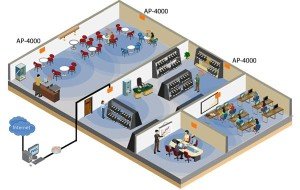 Last year, voters approved Proposition 30, temporarily increasing the state sales tax by a quarter-cent and income taxes on the wealthy by 1 percent to 3 percent. The move staved off what Gov. Jerry Brown said would have been $4.8 billion in cuts to K-12 education last year but did not infuse new money into education coffers.
Last year, voters approved Proposition 30, temporarily increasing the state sales tax by a quarter-cent and income taxes on the wealthy by 1 percent to 3 percent. The move staved off what Gov. Jerry Brown said would have been $4.8 billion in cuts to K-12 education last year but did not infuse new money into education coffers.
“Some people thought Prop. 30 cured everything,” Torlakson said. California’s third- through 11th graders are set to test the new standardized testing system this spring. California bucked demands of U.S. Secretary of Education Arne Duncan when lawmakers this month approved the suspension of the Standardized Testing and Reporting, or STAR, program — a major component of the Federal accountability system.
Instead, students will participate in a field test of the Smarter Balanced exam that is being called a “test of the test” and will highlight how prepared schools are to give the exam entirely on computers. While all tests must be administered on computers next spring, paper-and-pencil exams will be available in the three subsequent years to schools that can prove their technology is inadequate to handle the administration of the test.
“Testing the test” next spring will let school administrators know whether they truly are prepared for spring 2015, when official test results will be released and counted. “We don’t want it to be like what happened in many states with the Affordable Care Act,” Torlakson said of the rocky opening weeks of health care exchanges. Online registration has been riddled with problems.
SANDY KRESS’ STAAR CHAMBER
By Jason Stanford – 3/26/12
This week millions of Texas schoolchildren, including my two sons, will be taking new standardized tests that represent the next generation in the fantasy that we can apply business metrics to public education.
education.
What started out as a well-intentioned attempt to leave no child behind has metastasized into a cult of standardized testing. But despite a top-to-bottom revolt against the tyranny of the test, no one is blaming the one man responsible for it all, Sandy Kress.
It’s hard to find anyone in Texas outside of the governor’s office defending what we euphemistically call “accountability in education.” Back in the early ‘90s, Texas was like every other state in the union and treated standardized test scores like diagnostic tools and not the result of education. The problem was that as we entered the Information Age, too many Texas schools were turning out kids ready for a “do you want fries with that” career.
Enter Sandy Kress, whom George W. Bush plucked from the Dallas School Board to help him apply the “You can’t manage what you can’t measure” mantra to public schools. It perhaps did not occur to Gov. Bush or Kress that Texas, which ranked dead last in per-pupil spending, might need to put more money into public schools. By punishing and publicizing failure, they reasoned, teachers and administrators would do more with less. The test scores became the only measure of how schools performed, and administrators and teachers became adept at preparing their students to pass the test. Book reports, dioramas, and lab experiments became a thing of the past as consultants instructed children on how to pass reading tests without actually reading the text.
Everyone got very good at taking the test. Test scores rose, and in 2003, then-Pres. Bush had Kress help convince Congress to apply the Texas model to the rest of the country with No Child Left Behind. The late Sen. Edward Kennedy even called Kress the president’s “smooth talker.” NCLB became the law of the land, and state spending on standardized testing exploded 160% to $1.1 billion in 2008.
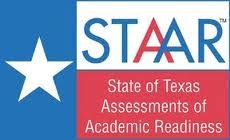 There was just one problem: It wasn’t working back in Texas. It wasn’t that the teachers and students weren’t trying. In fact, they were stressing themselves out over the tests. Nervous stomachs became so common that one test company included instructions for teachers on what to do if a student vomits on the test.
There was just one problem: It wasn’t working back in Texas. It wasn’t that the teachers and students weren’t trying. In fact, they were stressing themselves out over the tests. Nervous stomachs became so common that one test company included instructions for teachers on what to do if a student vomits on the test.
When they weren’t getting sick on the tests, Texas kids kept getting better scores on Texas’ test but failed to make real progress when measured against students in other states. Even more alarmingly for the Information Age employers, 38% of those who showed up to Texas community and technical colleges showed up not ready to take college-level math.
When Gov. Rick Perry saw these results, he didn’t question the basic model, because that would have forced him to put evidence ahead of his pro-business ideology. Instead, he grabbed Sandy Kress with both hands and made him his own. Perry appointed Kress to the Select Committee on Public School Accountability and the Governor’s Business Council and named him chairman of both College Ready Texas and the Governor’s Competitiveness Council.
Perry did everything but put Kress on his payroll, but Kress was making too much money in his day job as a lobbyist for Pearson Education, the company that had been writing the tests in Texas all along, as well as practice tests, classroom handouts and textbooks. And Kress was making so much money for Pearson that even the oilmen were getting jealous. In 2000, Pearson signed a $233 million contract to provide tests for Texas schools, and in 2005 they got another $279 million.
But in 2011, things were dire in Texas. Rick Perry told the Texas legislature to close a $27 billion deficit without raising taxes or dipping into cash reserves, in effect all but ordering lawmakers to cut both schools and health care. But cutting education threatened the testing budget, which Perry, his business backers and, of course, Kress the Pearson lobbyist, could not allow.
Perry dispatched Kress to testify in legislative hearings on his behalf without advertising his connections to the company that stood to gain the most. In DC, a lobbyist masquerading as an administration official would require a special prosecutor and a congressional hearing. But in Texas, it’s just business as usual, a natural extension of applying what people think works in the boardroom to the classroom.
 In the end, Perry got his way, and legislators cut $5 billion from the education budget without touching $5 billion in cash reserves, just like Perry wanted. Less well known is the $470 million contract that Perry’s administration signed with Pearson Education to come up with a new test that will hold Texas schoolchildren to a higher standard at the same time that budget cuts are forcing them into increasingly crowded classrooms. If the old test punished failure, this new one—the State of Texas Assessments of Academic Readiness—enforces excellence. The new watchword is “rigor,” and for the first time, the tests will make up 15 percent of the grades of high school students in English, history, math and science.
In the end, Perry got his way, and legislators cut $5 billion from the education budget without touching $5 billion in cash reserves, just like Perry wanted. Less well known is the $470 million contract that Perry’s administration signed with Pearson Education to come up with a new test that will hold Texas schoolchildren to a higher standard at the same time that budget cuts are forcing them into increasingly crowded classrooms. If the old test punished failure, this new one—the State of Texas Assessments of Academic Readiness—enforces excellence. The new watchword is “rigor,” and for the first time, the tests will make up 15 percent of the grades of high school students in English, history, math and science.
There is no secret how Kress managed to increase funding for his client while forcing legislators to cut school funding for the first time since the Great Depression. “There was a dude in the back room with a veto pen staring people down,” said Kress.
The new test has incited a revolt in Texas. More than 100 school boards have passed resolutions condemning the “over-reliance” on standardized tests that is “strangling” our public schools, and even Perry’s own education chief has called the “end-all, be-all” treatment of testing as a “perversion” of what schools should be doing and likened the “the assessment and accountability regime” to the “a military-industrial complex.”
The budget negotiations took so long that schools received the new tests late, meaning teachers didn’t have enough time to prepare students to take it. The state had to waive accountability measures for this year. And so many teachers, parents and administrators complained about not being ready to teach the test that school districts have been allowed to exempt their students from the test applying 15% to their grades. All of this means that the result of the New Rigor is that absolutely no one will be held accountable for the test scores, not one school, principal, teacher or student. Accountability in education began as an effort to end social promotion, but all Texas has received so far for Pearson’s $470-million contract is anti-social promotion.
When I send my sons to school in the morning, I will tell them what I’ve always told them about the standardized tests. The tests are an opportunity to write down what they have learned, and I could not care less about the result. They know Rick Perry’s behind all this, so they understand. I’m not sure how to explain who Sandy Kress is.
CALIFORNIA MAY LOSE ‘NO CHILD LEFT BEHIND’ WAIVER BID
By Christina Hoag ‘Associated Press 12/26/12
LOS ANGELES (AP) — Federal education officials are poised to reject California’s self-styled bid to avoid the strict requirements of the No Child Left Behind law, which could lead to radical reforms at hundreds of low-income schools. State Superintendent of Public Instruction Tom Torlakson said U.S. Department of Education officials informed him last week that they were prepared to deny the state’s waiver application, although the rejection has not yet been formally issued.
“I look forward to thoroughly examining the rationale the administration provides for its decision and will continue to explore every avenue for providing California’s schools and students the relief they deserve,” Torlakson said in a statement. After missing two deadlines for waivers, California in June submitted a last-minute, customized exemption from the Elementary and Secondary Education Act, as No Child Left Behind is formally known. The state said even though it did not comply with the specifics of some waiver requirements it was adhering to them in principle.
U.S. education officials did not return a request for comment Wednesday. The department has received a total of 47 waiver requests, and approvals have been issued to 33 states and the District of Columbia so far. Under the law’s key provision, schools must raise all students to proficiency levels in English-language arts and math by 2014. If a waiver is not obtained and Congress does not revise the law, Torlakson has said that more than half of California’s low-income schools would be labeled as “failing.” That could lead to radical reforms such as state takeovers and charter conversions, and affect hundreds of millions of dollars in federal funding. Critics have long charged that No Child Left Behind is too inflexible and relies too heavily on standardized test scores. The result has been that too many schools have been classified as failing, they say.
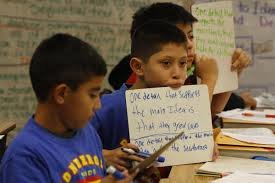 Last year, the Obama administration agreed to issue a two-year waiver for states that meet three main criteria: adoption of rigorous academic achievement standards, a program to focus on turning around low performing schools, and the most contentious provision, an accountability system that would involve using test scores to evaluate teachers and principals. But Torlakson said waivers should be granted without strings attached and said the requirements were too costly for a state mired in fiscal problems. State education officials estimated it would cost $2 billion to $2.7 billion to meet the waiver criteria. The state has already committed to the first requirement through the adoption of the national curriculum known as the Common Core State Standards, but the state’s main teachers’ union, the California Teachers Association, has steadfastly refused to agree to incorporate test scores as a measure of classroom performance.
Last year, the Obama administration agreed to issue a two-year waiver for states that meet three main criteria: adoption of rigorous academic achievement standards, a program to focus on turning around low performing schools, and the most contentious provision, an accountability system that would involve using test scores to evaluate teachers and principals. But Torlakson said waivers should be granted without strings attached and said the requirements were too costly for a state mired in fiscal problems. State education officials estimated it would cost $2 billion to $2.7 billion to meet the waiver criteria. The state has already committed to the first requirement through the adoption of the national curriculum known as the Common Core State Standards, but the state’s main teachers’ union, the California Teachers Association, has steadfastly refused to agree to incorporate test scores as a measure of classroom performance.
Instead, California based its waiver application on its current measure of school achievement, called the Academic Performance Index, and several initiatives under way to boost teacher effectiveness.” Taken together, these initiatives will provide California the opportunity to redesign the system of school accountability to ensure that it is more meaningful and more inclusive than the current federal accountability system,” Torlakson wrote in a letter Friday to district superintendents. School reformers said the waiver rejection shows that California is increasingly out of step with educational progress nationwide.
If the state had submitted an adequate application, low-income schools would also have gained flexibility in how they can use federal money, noted Erin Shaw, spokeswoman for Students First, a Sacramento-based reform group. “This unfortunately comes at a time when school budgets remain tight and the `fiscal cliff’ looms,” Shaw said in a statement. “California has already left millions of badly needed federal dollars on the table by failing to submit competitive applications for `Race to the Top’ funding. It’s time to change the system that rejects accountability and continually risks classroom resources that rightfully belong to students.”
The teachers association and Torlakson have said they are in favor of Congress rewriting the Elementary and Secondary Act to incorporate state policy differences and to give more flexibility.
SCHOOL TESTING STANDARDS TO CHANGE
By Robin Hug, Healdsburg Tribune 9/13/12
Eight hundred minutes is a long time to sit through tests, especially for a child, but the days of traditional standardized testing will soon change as California schools move toward a new initiative. The Common Core State Standards (CCSS) Initiative was first introduced by the National Governors Association Center for Best Practices and with the help of teachers, school administrators and education experts, new standards and skill requirements have been developed with the goal of creating consistency across the country.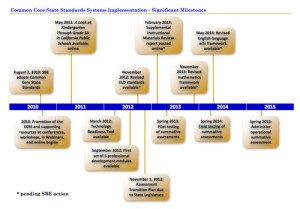
As the 2012 STAR test scores are released, Sonoma County schools are also preparing for major changes in the testing and accountability system in California. In 2010, the California State Board of Education became one of 45 states to adopt the new standards and the transition is now under way. Assessments aligned with those standards are in development and are expected to be in place for the 2014-15 school year, replacing the STAR tests.
“The test itself is going to be very different in nature, there are two options that states could take for the test and California chose to join a consortium called Smarter Balanced,” said HUSD Director of Curriculum Annie Millar. Smarter Balanced is an online test delivery program that allows for achievement measurement of the Common Core State Standards. Students will answer questions and as they move through the test the program will adjust according to the student’s level.
“We will be able to get an accurate read of what the student can and can’t do at that point in time and the other thing that is really key is that it is planned that there will be check points along the year to get students some assessment leading up to the big test,” Millar said. Millar noted that having this data and immediate feedback will help guide teachers on how to group students and target skills that they haven’t yet mastered before testing.
 The STAR tests have been administered in California since 1998, and were aligned with the state content standards in 2003. Students receive one of five scores—advanced, proficient, basic, below basic, and far below basic—in each subject tested at their grade level. This year marked ten years of standards-aligned STAR test data now available for Sonoma County schools, showing that both English Language Arts and Mathematics learning has increased in classrooms across the region.
The STAR tests have been administered in California since 1998, and were aligned with the state content standards in 2003. Students receive one of five scores—advanced, proficient, basic, below basic, and far below basic—in each subject tested at their grade level. This year marked ten years of standards-aligned STAR test data now available for Sonoma County schools, showing that both English Language Arts and Mathematics learning has increased in classrooms across the region.
“I am impressed that our schools have continued to move forward in the current environment,” said Dr. Steven Herrington, Sonoma County Superintendent of Schools. “Over the past five years, we’ve had to cut $60 million dollars from local school district budgets. This has led to larger classes, fewer after-school programs, and less individual assistance to struggling students.”
The STAR test includes sections on reading, writing, spelling, math, science and history. Students begin taking the STAR tests in second grade and take it every year following through their junior year in high school. The test is spread out over the course of a week, sometimes two, depending on the school. Results are used to determine whether schools have met the growth targets specified by the state’s Academic Performance Index (API) program and the requirements of the federal No Child Left Behind Act.
The report on these federal and state accountability measures is scheduled for release in early October. More than 53,000 Sonoma County students in grades 2-11 took the Standardized Testing and Reporting (STAR) exams last spring. Sixty-one percent scored proficient or advanced in English Language Arts, up from 58 percent one year ago and four percentage points ahead of the state average. Scores rose at every grade level except one (tenth grade), which dropped by just one percentage point from last year’s results. “Increasing reading proficiency is a county goal and this shows that we are making continued progress,” said Dr. Herrington.
In math, 52 percent of students scored proficient or above, which is a one-point drop from last year. A grade-by-grade analysis shows that the 2012 test scores were down at the high school level when compared to 2011, and mixed at the elementary and middle grades. The 10-year trend for mathematics is still positive at all grade levels, except for high school geometry where scores have bounced up and down from year to year. At the same time that Sonoma County experienced this one-year dip in its math results, the statewide average score for mathematics increased. As a result, the percentage of Sonoma County students scoring proficient or above in math is now equal to the state average.
“Our hope and expectation is that this is a one-year leveling off and that our math scores will rebound next year,” said Mickey Porter, assistant superintendent for instructional services at the Sonoma County Office of Education. “Sonoma County has always performed above the state average and we have a strong 10-year track record in mathematics.”
Students were also tested in History-Social Science and Science at various grade levels. The county has continued to show gains in most areas tested and the countywide summary scores in these content areas are trending up.
More information about the STAR program and school, district, county, and state results are available on the California Department of Education website, http://star.cde.ca.gov. Information on CCSS can be found at www.corestandards.org.
STANDARDIZED TESTS FOR EVERYONE? IN THE INTERNET AGE, THAT’S THE WRONG ANSWER
By Cathy N. Davidson September 23, 2011
When Frederick J. Kelly invented the multiple-choice test in 1914, he was addressing a national crisis. The ranks of students attending secondary school had swollen from 200,000 in 1890 to more than 1.5 million as immigrants streamed onto American shores, and as new laws made two years of high school compulsory for everyone and not simply a desirable option for the college bound. World War I added to the problem, creating a teacher shortage with men fighting abroad and women working in factories at home.
 The country needed to process students quickly and efficiently. If Henry Ford could turn out Model Ts “for the great multitude,” surely there was an equivalent way, Kelly wrote in his dissertation at Kansas State Teachers College, to streamline schooling. What he came up with was the Kansas Silent Reading Test, sometimes called the “item-response” or “bubble” test.
The country needed to process students quickly and efficiently. If Henry Ford could turn out Model Ts “for the great multitude,” surely there was an equivalent way, Kelly wrote in his dissertation at Kansas State Teachers College, to streamline schooling. What he came up with was the Kansas Silent Reading Test, sometimes called the “item-response” or “bubble” test.
Today, American public school students are still taking versions of Kelly’s test. End-of-grade exams, required under the No Child Left Behind law, are modeled after his idea: Fill in the circles. There is only one right answer. Stop when time is called. The Obama administration is currently undertaking an important overhaul of key parts of No Child Left Behind, the George W. Bush administration’s signature education law. Perhaps that reform needs to go even further. Antiquated standardized tests are still serving as the backbone for measuring achievement. Our students can’t escape Kelly’s century-old invention.
We often forget that there is nothing fixed or natural about “school” but that, like all institutions, it evolves in response to historical circumstances. In the case of standardized testing, the multiple-choice exam has had an impact far beyond the crisis that inspired it, and a reach and application far beyond what its inventor intended. From his papers  at the University of Idaho, it is clear that Kelly didn’t mean for standardized testing to become so widespread. Although he argued for uniform ways of judging achievement, he also indicated that his Kansas Silent Reading Test was intended to measure “lower-order thinking” among the masses (which were then called the “lower orders”). But this form of testing is, of course, now the gold standard for just about everything, from No Child Left Behind tests to college entrance exams to tests for graduate and professional schools.
at the University of Idaho, it is clear that Kelly didn’t mean for standardized testing to become so widespread. Although he argued for uniform ways of judging achievement, he also indicated that his Kansas Silent Reading Test was intended to measure “lower-order thinking” among the masses (which were then called the “lower orders”). But this form of testing is, of course, now the gold standard for just about everything, from No Child Left Behind tests to college entrance exams to tests for graduate and professional schools.
Once World War I was over, Kelly himself began to ardently champion a different direction for educational reform, a model of liberal, integrated, problem-based learning. In his inaugural address as University of Idaho president in 1928, he argued for expansive changes almost diametrically opposite to his early advocacy of standardized testing. “College is a place to learn how to educate oneself rather than a place in which to be educated,” he insisted.
Too late. By then, the College Entrance Examination Board had adopted Kelly’s test as the basis for its Scholastic Aptitude Test (SAT). Business schools and schools of education were using item-response testing as the new metric for measuring success. Kelly’s faculty was furious that the inventor of the bubble test now advocated a different course, and he was asked to step down as president barely two years later.
Kelly couldn’t get rid of the test he created, but we should be able to. Institutions of education should be preparing our kids for their future — not for our past. In the Internet age, we are saddled with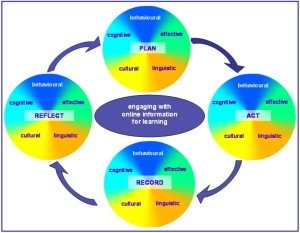 an educational system that was designed for the industrial age, modeled on mass production and designed for efficiency, not for high standards.
an educational system that was designed for the industrial age, modeled on mass production and designed for efficiency, not for high standards.
A standard test question for young students today, dating back to Kelly’s original exam, is which of four animals is a farm animal (a cow, a tiger, a rat or a wolf). The same child who flubs this question can go home, Google “farm animals” and get 14.8 million results. What part of our educational system prepares a student to sort through and evaluate all those Web sites? Multiple-choice exams do not equip kids for either the information avalanche or the fine print that they encounter online every day.
In a decade of researching digital education, I have never heard an educator, parent or student say that the tests work well as teaching tools. Beyond the flaws of these rigid exams — which do not measure complex, connected, interactive skills — there is little room in the current curriculum or even in the current division of disciplines (reading, writing, math, natural sciences and social studies) for lessons about key questions that affect students’ daily lives. Teaching kids about credibility, security, privacy, intellectual property and other bases of their online lives, after all, would take time away from the tested subjects that lead to merits or demerits, funding or reduced funding, depending on exam scores. Yet every school curriculum should include interactive lessons in practical, creative and cautious participation in the World Wide Web. Ideally, students should be learning these lessons even as they learn the basics of code.
We’re facing a crisis in education today, much like Kelly faced in 1914. The U.S. high school completion rate is dropping slightly in real terms, and dramatically relative to other industrialized nations. But even more serious is the rate at which teachers are leaving the profession. Teacher attrition has increased by more than 50 percent in the past decade, and it is often the best teachers who leave first, many citing the demoralizing testing requirements of No Child Left Behind.
Right now, we have teachers, out of self-preservation and to protect their schools and their students, teaching to a test that was designed in the era of the Model T. We are 15 years into the information age. Now is the time to begin to rethink how we assess learning for the challenges of the digital world that lie ahead. It’s not as simple as filling in the bubbles.
THE ILLUSION of the ‘GIFTED’ CHILD
By Andrew J. Rotherham April 25, 2013
When news broke late last week that behemoth education company Pearson had bungled the scoring of standardized tests used for admissions to gifted education programs in New York City, it united Gotham’s quarreling education community — everyone was outraged. Parents, teachers and city officials all had good reason to be, as the scoring errors would have denied admission to 2,700  students who qualified. But the incident also highlighted the arbitrary nature of how we decide which students are so superior academically that they are essentially funneled into an elite group of schools with a specialized, advanced curriculum.
students who qualified. But the incident also highlighted the arbitrary nature of how we decide which students are so superior academically that they are essentially funneled into an elite group of schools with a specialized, advanced curriculum.
For starters, what exactly makes a child “gifted”? In New York City, like many school districts, giftedness is decided by a standardized test that measures verbal and nonverbal facility. Score at the 90th percentile and you make the cut for some programs, but at the 97th percentile students become eligible for the highly competitive citywide options for gifted students. The problem isn’t the test, per se, it’s the false precision that comes with it. There is no consistent standard — some experts say the top 10%, some say the top few percent (in which case, most of the children whose parents think they are gifted are merely talented). In the case of New York City, does anyone seriously think that a student at the 96th percentile (or the 89th for that matter) might not benefit from gifted education programs, as well? Of course not. It’s the scarcity of seats, rather than any rigorous definition of merit that is driving these distinctions.
Then there are the limits of standardized testing. We certainly should support students with high academic potential, but it’s hardly the only measure of human potential. Some school districts identify students with talents in the visual and performing arts, for instance, for various gifted programs. But in general, the measure for defining giftedness is narrow — and can be manipulated by access to test-prep programs.
 This is one example of why class and race also matter. Affluent parents have resources to help their children do better on tests. Low-income and minority students are substantially underrepresented in gifted programs. The more general problems of low school quality for poor and minority students likewise matter. A 2007 report from the Jack Kent Cooke Foundation found that 3.4 million high-performing low-income students are being overlooked by today’s policies. Not as exciting as occupying a park, but these are the real drivers of America’s lack of social mobility.
This is one example of why class and race also matter. Affluent parents have resources to help their children do better on tests. Low-income and minority students are substantially underrepresented in gifted programs. The more general problems of low school quality for poor and minority students likewise matter. A 2007 report from the Jack Kent Cooke Foundation found that 3.4 million high-performing low-income students are being overlooked by today’s policies. Not as exciting as occupying a park, but these are the real drivers of America’s lack of social mobility.
So what can policymakers and school districts do to create better policies for gifted students? Here are three ideas:
1. Increase the options. In New York City and elsewhere, gifted programs often function as a school-choice strategy for making public schools more attractive. But demand clearly overwhelms supply. Students with different kinds of giftedness should be able to find schools that work for them, and giving parents more options does a lot more to get them invested in public education than an annual fight over a limited number of seats in coveted programs.
2. Level the playing field. Providing extra support for students from diverse backgrounds is essential. Programs aimed at students by race or incomes are suspect in today’s politics, but a high bar is only meaningful if all students have the chance to meet it.
3. Just make our schools better. Efforts to improve the quality of curriculum and instruction are good for everyone. So is expanding access to pre-K education. It’s no secret that too many American students aren’t challenged in school. While programs for truly exceptional students have a place, all kids would benefit from more enriching and rigorous educational experiences and more would be seen as “gifted” with a better educational experience at their back.
WHY OUR NATION NEEDS COMMON STANDARDS
By Jonah Edelman
Hechinger Report July 18, 2013
Shane Cockrell’s father was in the military, and the family moved a lot when he was growing up. Cockrell specifically recalls starting middle school in Connecticut, and then enrolling in a middle  school in South Carolina when the family moved. The decline in standards was shocking. “My mom was so appalled by the difference that she ended up pulling me out of public school,” Cockrell recalls. Now, Cockrell is himself a former member of the military with a family, and he can understand his mother’s frustration. His son was in an excellent accelerated program in Springfield, Mo., but when the family moved to Oklahoma, the “accelerated program” Cockrell had researched turned out to consist of occasional library visits. “I’m angry with myself because I felt like I did him a disservice by moving,” Cockrell said. His son is bored, and his grades have slipped.
school in South Carolina when the family moved. The decline in standards was shocking. “My mom was so appalled by the difference that she ended up pulling me out of public school,” Cockrell recalls. Now, Cockrell is himself a former member of the military with a family, and he can understand his mother’s frustration. His son was in an excellent accelerated program in Springfield, Mo., but when the family moved to Oklahoma, the “accelerated program” Cockrell had researched turned out to consist of occasional library visits. “I’m angry with myself because I felt like I did him a disservice by moving,” Cockrell said. His son is bored, and his grades have slipped.
It makes no sense that standards for students vary dramatically from state to state. NPR recently reported that a fourth-grader in Arkansas might be rated “proficient” on his state test but could be deemed failing if he lived in Massachusetts. In 2009, 90 percent of Tennessee fourth-graders were on track in reading, according to the state’s assessment. But only 28 percent of them were up to muster on the National Assessment of Educational Progress, also known as the Nation’s Report Card, which is widely considered the most reliable and rigorous national assessment of student learning.
In addition to being bad for students, the current hodgepodge of academic standards prevents teachers from collaborating across state lines, according to Seria Walton, a former Teacher of the Year in Lansing, Mich. “I was on a leadership team with teachers from a variety of different states, and as we looked at each other’s standards, we realized there was no continuity. They were vastly different. We couldn’t collaborate on lesson plans because no one was teaching the same thing.” Walton also had to completely change all of her lesson plans when she moved to Indiana from Michigan. “I had to reinvent the wheel for what to do with the kids,” she said, “and there were so many Indiana standards, it was impossible to teach  anything in depth.”
anything in depth.”
The Common Core Standards—clear and high standards for what every child in the United States should know by the end of each grade—are a practical and effective solution for a system that now dooms some students to learn far less than their peers who happen to live in other states. They benefit students in states with weak academic standards. They benefit teachers who want to access and share the best possible lesson plans. They benefit parents who have a right to know that an “A” in school or a “proficient” on the state test actually means their child is on track. They benefit military families who often move across state boundaries. They benefit colleges and employers, who for the first time will know that a high-school graduate from Arizona is as prepared as one from New York when it comes to the critical reading, critical reasoning, and foundational math skills necessary for college and career success. They benefit college-aged students, many of whom now take costly remedial classes (without earning college credit) because their previous schooling didn’t prepare them for higher education.
People tend to support the Common Core State Standards once they understand them. Last month, in a poll of likely voters conducted by Stand for Children Oklahoma, 78 percent of respondents expressed support for standards that put all students on the path to high-school and college graduation.
Here’s how Shane Cockrell, who wasn’t even familiar with the new common standards, made the case: “Shared standards will mean parents who travel state to state know exactly what to expect out of schools in a new state. And, raising standards everywhere makes it more feasible for kids in poor areas to know they have a fighting chance. “Isn’t that just common sense?” Cockrell asked. Jonah Edelman (@JonahEdelman) is co-founder and CEO of Stand for Children.

Recent Comments